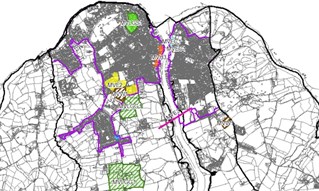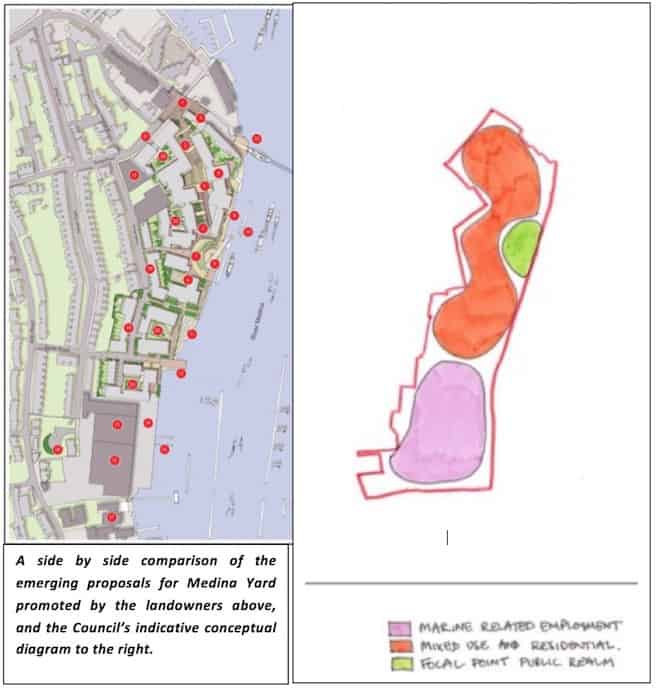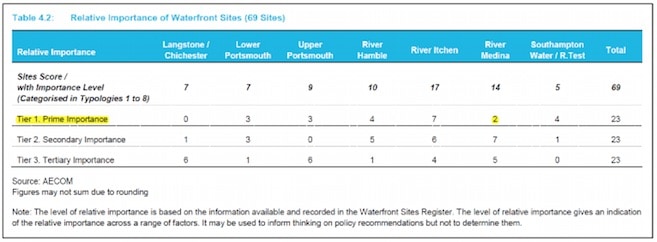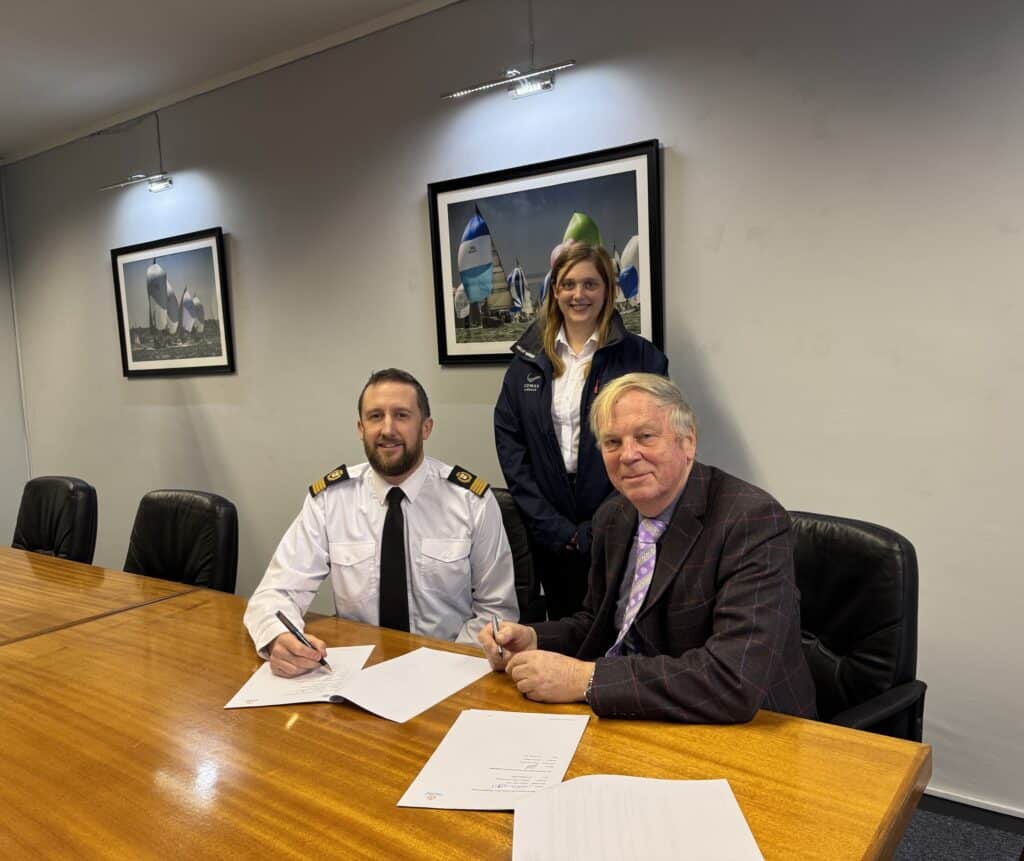
Cowes Harbour Commission (CHC) submitted (on 17th December 2015) a formal response to the Isle of Wight Council’s Medina Valley Area Action Draft Plan Consultation. The CHC response highlights that in the Commission’s opinion the draft Area Action Plan (AAP) for the Medina Valley provides insufficient protection for existing commercial marine sites with good water access, to meet both current and future needs. The full response is published below:
RESPONSE TO MEDINA VALLEY PLAN CONSULTATION DRAFT (2015)
Capt. Stuart McIntosh, the Cowes Harbour Master, and I, as Chairman of the Cowes Harbour Commission, are writing in response to the recently published consultation draft Medina Valley Area Action Plan. We wish to submit comments on some fundamental issues as they affect both the interests of the Harbour Commission itself, and important local economic interests, which are supported by harbour activities. Our response confirms that in our opinion the draft AAP provides insufficient protection for existing commercial marine sites with good water access to meet both current and future needs.
Background
As background to this submission, we offer clarification of the responsibilities of the Cowes Harbour Commission. Cowes Harbour is a trust port and has no shareholders or other owners, but is managed for the benefit of its users and stakeholders. It is governed by a Board of 10 Harbour Commissioners appointed through a public selection process, who work on a voluntary basis. The Commissioners appoint the Harbour Master who, with a team of delegated officers, has day-to-day responsibility for the running of the harbour. The Harbour Commission’s functions, and roles as a statutory harbour authority, are set out in national legislation and various Harbour Revision Orders that date from 1897 to 2012.
The Harbour Commission’s objectives support sustainable management and development of Cowes Harbour. These objectives are outlined in the Commission’s strategic framework document (version 3), published in May 2011. The core business policy of harbour development states the following:
To maintain and develop sustainable Harbour development strategies so as to safeguard existing, and promote new business, investment and employment opportunities.
We wish to declare that the Cowes Harbour Commission is a landowner and owns property at Kingston Wharf, Shepards Wharf and Town Quay, which are investments supporting the economic development of the harbour and Medina Valley. The Harbour Commission has also worked in partnership with the Homes and Communities Agency (HCA) to deliver the Cowes Breakwater Project to transform Cowes into a true sheltered harbour. This is a major step towards improving navigation safety and encouraging further investment in and around the harbour.
On 3rd November 2015, I wrote to Councillor Jonathan Bacon, the leader of the Isle of Wight Council, and Mr Gary Jefferies, Chairman of the Solent Local Enterprise Partnership (LEP), to highlight the risks to important employment sites with good access to navigable water. The letter stressed the need for a long-term vision to ensure the sustainable future for marine-based employment and investment in Cowes in the light of current planning applications and other emerging proposals. Gary Jefferies of the Solent LEP replied, helpfully, and cited recent work commissioned as an independent study into waterfront employment sites across the area. As yet, the Harbour Commission has not received any reply from the Isle of Wight Council.
Policy MVE3: Employment Sites with Water Access
The Cowes Harbour Commission strongly supports this policy as it enables the creation and retention of maritime and marine related jobs, and specifically relates to the importance of employment sites where there is water access. The policy requires the Council to resist the loss of existing sites as well as encouraging new ones.
Surprisingly, there is no mention of the Kingston Marine Park. Whilst it is accepted that this site offers some opportunity by way of new development land for marine industries, there is, as yet, no direct deep-water access. This serves to further highlight the importance of preserving existing water frontage sites with good access.
Policy MVE1 : Employment Growth
The Cowes Harbour Commission supports this policy as it recognises the importance of the Medina Valley area as a whole in the provision of jobs. It encourages further delivery of sites for small and medium sized business, and the availability of affordable and flexible commercial floorspace. This policy provides a robust basis for supporting proposals for new job creating uses and development.
Policy MVEC1 : East Cowes Regeneration Area
The Cowes Harbour Commission supports this policy for the continued regeneration of East Cowes and the creation of upgraded marine-based commercial sites, including adequate provision of direct deep-water access, and the improvement of port facilities for Red Funnel. We suggest the Isle of Wight Council, as local planning authority, should ensure that it works to encourage investors, and stakeholders to play a proactive role in delivering the sound and sustainable regeneration of East Cowes.
Policy MVH2 : Medina Yard
The Cowes Harbour Commission strongly objects to the policy allocating Medina Yard for mixed use development that would see a significant reduction in marine based industrial floorspace and commercial water frontage. The local planning authority appears to view Medina Yard as a contributor to housing delivery, rather than a major site that could support ongoing development of marine industries in the Cowes and wider Solent area. This approach is a contradiction to Policy MVE3 that seeks the retention and protection of marine employment sites with water frontage.
Medina Yard provides naturally self-scouring deep-water frontage. It is the most important marine-employment site in the Medina Valley. The northern part of the site, earmarked for residential development in the conceptual diagram (Figure 1), has a quayside frontage that draws a depth of 5m below chart datum, ideal for commercial marine activities. The southern half of the site, identified for potential marine-related employment uses, has a reduced depth of between 1.8 and 3m below chart datum. The site currently accommodates a significant number of jobs. Our understanding is that there are approximately 80 jobs in small, single or marine based enterprises, a further 80 at South Boats, and 12 at Red Ensign.
The indicative conceptual diagram (Figure 1) is very concerning given the emphasis on residential uses, over commercial marine-based activity. It also matches very closely, the emerging proposals currently being promoted by the Medina Yard site owners. The Commission is concerned that the draft policy is pre-empting a decision to grant outline planning permission for the redevelopment of the site, along the lines currently being proposed. The similarity between the elements of the draft policy and the recent draft consultation on development proposals for the Medina Yard is too close for comfort, particularly since the local planning authority appears to have disregarded its own draft policy seeking the retention of water access sites.

Figure 1.
It is also relevant that the assumed use of the Medina Yard for housing is questionable since the costs of development of the site mean that little, if any, affordable housing could be provided. Effectively, existing and potential marine-related jobs would be lost at the expense of residential development. Once sites are lost to non-B use classes such as residential or retail, it is highly unlikely that they will ever be converted back to support marine and maritime use meaning that their capacity to support the marine and maritime sector will be lost forever.
The Need to Protect Deep Water Frontage: Medina Yard is designated Tier 1 importance
The Solent Local Enterprise Partnership (LEP) published ’Maritime Futures: Solent Waterfront Sites’ in September 2015. It is an up-to-date evidence-based evaluation of waterfront employment sites in the Solent region, prepared specifically to inform decisions taken by local planning authorities. It draws conclusions on the retention of key sites, and highlights their importance through a site categorisation process. Out of the 69 sites assessed across the Solent, just 23 are considered to be Tier 1 – Prime Importance. Just two of these are on the Island (Figure 2). They are Venture Quays and Medina Yard. They represent prime potential for growth and new marine-based investment.

Figure 2. Table taken from Solent LEP ‘Solent Waterfront Sites’ September 2015
It is extremely concerning that the draft policy for Medina Yard ignores the outcomes and conclusions of the Solent LEP study. It is worth highlighting the following comment from the report that states (paragraph 1.1.5):
The loss of land at strategic waterfront locations reduces the Solent area’s ability to provide the right sites and cater for demand from the marine and maritime sector, which is currently growing…..
This Solent LEP study on supply therefore has implications for employment retention and growth in the marine and maritime sector, supporting competitiveness and securing inward investment to the Solent area.
The traditional local shipbuilding skills and experience has enabled Cowes to develop into a commercial and leisure aluminium and composite vessel building centre of excellence, and the Island needs to continue to maintain and develop these specialist skills. There is, however, growing pressure on existing marine-based companies at Medina Yard, given the short-term leases and the emerging re-development proposals. Future investors need to be offered a choice of sites to ensure that the relocation or expansion of employment generating marine industries, are as unconstrained as possible, and make the best use of existing all-tide deep-water access.
Conclusion
The draft AAP outlines a number of strategic objectives that are supported by Cowes Harbour Commission, including the aim to protect marine based jobs and water frontage sites. However, the proposed mix of uses for Medina Yard contradicts this approach. This proposal puts the long-term future of Cowes Harbour as a marine-based construction centre seriously at risk. We suggest the Isle of Wight Council should be more proactive in identifying and protecting sites such as Medina Yard and Venture Quays. This would support economic regeneration needs and avoid the temptation to lose such sites to residential development as a consequence of the squeeze to meet housing targets. There is currently inadequate recognition and protection for commercial marine sites with good water access in the Medina Valley.
It is requested that the Isle of Wight Council register the response by the Cowes Harbour Commission to the draft Medina Valley Area Action Plan. Its views on the protection of deep-water frontage and opportunities for long-term major investment into marine industries should be given significant weight in the review of emerging policy. The Solent LEP study provides evidence of the need to protect important marine-based business sites, and we strongly suggest the Council therefore reassesses its proposed stance on emerging proposals for Medina Yard.
The Cowes Harbour Commission would welcome the opportunity to engage further in discussions with the Isle of Wight Council. As such, we look forward to receiving a response on how these matters may be discussed on a joint approach to ensuring the long-term future of marine industries in Cowes Harbour.
Roger Mathias – Chairman Cowes Harbour Commission
Capt. Stuart McIntosh – Cowes Harbour Master
Notes
The IWC consultation runs until midday on Monday, 21st December. Comments can be submitted via email to policy.consultation@iow.gov.uk or in writing to the following address:
Planning Policy, Seaclose Offices, Fairlee Road, Newport, Isle of Wight, PO30 2QS.
Top image: Section from the Medina Valley Plan Proposals Map – draft consultation version.




